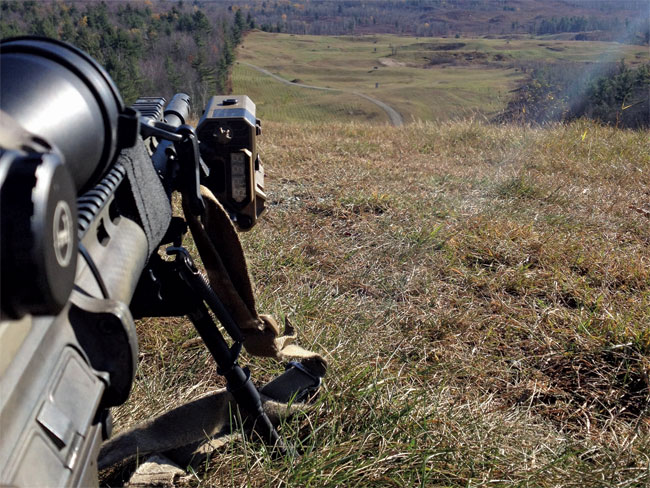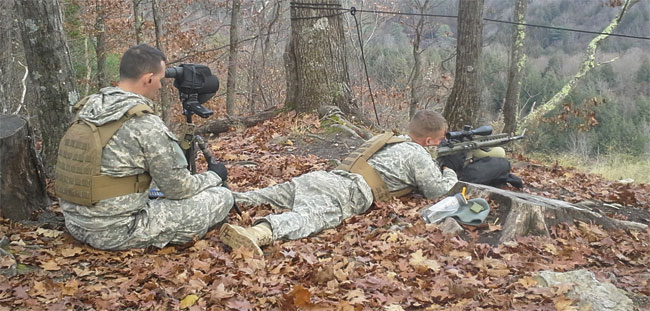ABOVE: Author conducting UKD engagement. The weapon is a LaRue Tactical OBR 7.62mm.
A defining moment for a sniper is when he can positively identify a threat within his area of operation and exercise certain actions, from an intelligence report to target neutralization. The ability to identify a target is vital in a stability operation or counterinsurgency (COIN) environment, where precisely aimed fire is at a premium and collateral damage isn’t an option.
The Basics: Calibrating Your Rifle Zero
Military sniping is an application that involves both precision and accuracy. Precision is from the characteristics of the rifle and ammunition. Precision is how well it prints group sizes, whereas accuracy is an indication of how a group of shots hit relative to the intended aim point, regardless of group size. The requirement for great accuracy is having a reliable zero. When you zero your weapon from different support positions, you can incur a different POI (point of impact). For the traditional sniper role, this will be from the prone bipod position. Realistically, the sniper will not always be able to shoot from the prone bipod position. Positional shooting (kneeling, standing) and even off a tripod is highly likely. A recommendation is to analyze POI shifts from those alternate support positions on a dot drill target at your zero range. If you see that when you shoot off a tripod you generally shoot .2 MILS low, you can accommodate for that error and add .2 MILS to your firing solution. Other POI shifts in your weapon’s zero can come from temperature effects and harmonics. Annotate these changes and account for them. Lastly, when zeroing, a three shot group isn’t recommended. A five round shot group, shot five times will give a good representation of the rifle’s inherent precision.
Un-calibrated sight adjustments are a common problem in long range shooting. Many snipers take for granted that when they dial up or hold a certain correction in a reticle, that they’re getting exactly the intended correction. In reality, it’s generally more often that there is some amount of error in a scope’s turret or reticle. As with every other measurement instrument, the turrets and reticle need to be verified before they can be trusted. The test to use to conduct the calibration is called “The Tall Target Test.” The tall target test is conducted in the following manner; remember, the Tall Target Test is a calibration exercise, so it’s very important to know the exact zero range. Verify with a LRF (laser range finder) or tape measure.
- Put up a tall target (36 inches tall) at your 100 (meter/yard) zero range. Have an aim point at the bottom of the target and a plumb line (leveled line) drawn up from the center of the aim point. You can use a carpenter’s level or a plumb bob to draw the vertical line.
- Shoot the lower aim point to verify your zero. Now dial your elevation turret up 30 MOA or 10 MILS. Still shoot at the aim point when doing this.
- After you have fired your groups, you can calculate the correction factor for that given scope. Measure from the zero group to the actual group for your 30 MOA increment.
Correction Factor: 1 MOA (minute of angle) equals 1.047 inches at 100 yards. 30 X 1.047 = 31.41 inches. Let’s say your scope only moved 29.5 inches: it’s only moving 94% as far as it should when it’s adjusted – 6 % less than it should move. Therefore, when you have to dial for elevation, you have to dial 106% of the intended adjustment. For example: You have a target that requires 30 MOA of elevation, but by doing the tall target test, you know that you actually need to dial 30 X 1.06 = 31.8 MOA in order to get a true 30 MOA on the scope.

The Tall Target Test is also a way to check if your scope is vertically tracking correctly. You want to eliminate any cant. Leveling your scope is very important and a necessity for long range shooting. Shooting with a verified leveled rifle and scope will promote in better wind reading since it will allow you to observe wind effects directly without an unknown component of cant. By shooting the Tall Target Test with your level installed, you will assure your wind zero is calibrated. Every sniper should have a scope level installed in order to prevent the accuracy damaging effects of cant.
MOA Consistency Errors
When it comes to a MOA standard across the industry, many manufactures fall short. Many manufactures will advertise MOA adjustments but fail to specify if the turrets and/or reticle are SMOA (shooter minute of angle 1 MOA = 1 inch at 100 yards), IPHY (inches per hundred yards) or TMOA (true minute of angle = 1.047 inches at 100 yards). This type of error equals a miss at 1,000 yards and can create a huge dilemma for a sniper team if one shooter is using X brand of scope and the other is using Y brand of scope. You’re speaking two different languages. One manufacture that gets this right is NightForce optics. They offer clear and concise descriptions of their scope turrets and reticles in the user manual.

Echelons of Capability
The latest craze taking over the military sniper community is the use of MIL based grid system reticles. Calibrated in USMC mils (6283 mils/circle) (1 mil = 3.60 inches at 100 yards) (10cm at 100 meters). These reticles let you visually place the target on the appropriate horizontal and vertical grid lines to correct for elevation and windage visually without turning knobs or counting clicks. These reticles are great for when you are in desert mountainous regions where you can generally see dust fly from misses, but once you move into an area of operation such as the Philippines, were foliage is dense, this type of reticle gets lost. A finer reticle, such as NightForce’s MIL-R reticle or the Mil Dot reticle offered in their scopes is excellent in dense foliage areas. It allows the sniper to stay focused on the center intersecting lines of the scope and offers an uncluttered FOV (field of view) of the target area.
Designated Marksman Solution
Reticles such as the TReMoR2 and CMR-W reticles are an excellent DM (Designated Marksman) solution. These types of reticles are a full minute of man tools, not long-range precision on partial obscured targets tools. For a line dedicated marksman outfitted with a 16-inch .308, these reticles can give the DM speed and accuracy to 600m effectively and beyond potentially. Generally, DMs are rightly being placed on support by fire lines in Afghanistan. Effective support by fire is critical for the assault team’s success and safety. DMs have the ability to engage point targets on the objective in close proximity to the assaulters. Today’s battle rifles such as the FN SCAR17s and LaRue OBR 7.62, outfitted with a variable power, lightweight scope such as the NightForce NXS Compact 2.5-10×42 in MIL/MIL configuration gives the DM an ideal platform to deliver 175 grains of diplomacy onto targets of opportunity.
Magnification
Magnification is a function of mission requirement, weight, cost and bulk. Magnification is an enabler when it comes to acquiring positive identification on a HVT (High Value Target) or the presence of small arms. A magnified scope will allow the sniper or DM to ID further and faster than shooters with minimal magnification like an ACOG or Short Dot. 9x or 10x magnification will get you to 1,000 yards, but magnification greater than 10x will give you precision aiming for smaller targets or partially exposed targets. One thing you have to be cautious of in First Focal Plane (FFP) scopes, the stadia line thickness increases with magnification, which could hinder the sniper in refining his aim point. Scopes with larger magnifications (3-20x and greater) tend to be heavier and bulkier then their lighter counterparts. Weight is an important consideration when it comes to mission planning. In the end, the Mission will drive the tools necessary to complete the mission. Snipers need to continue to evolve and progress. Don’t let the lessons we learned from over a decade of fighting go by the wayside with the drawdown. Continue to reinvent the wheel and fine-tune the greatest all weather, day and night offensive and defensive firing platform, the SNIPER.










